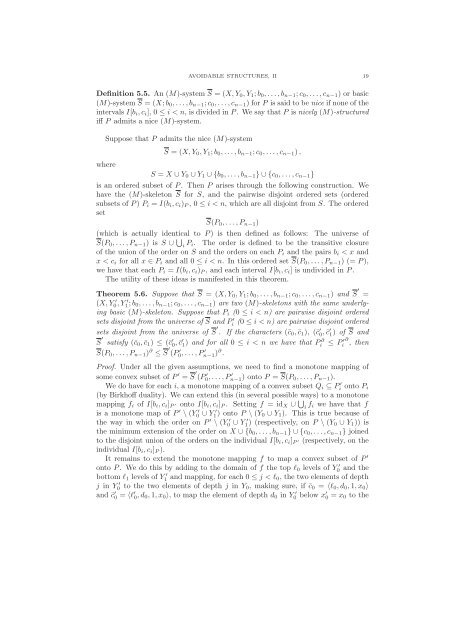Avoidable structures, II: finite distributive lattices and nicely ...
Avoidable structures, II: finite distributive lattices and nicely ...
Avoidable structures, II: finite distributive lattices and nicely ...
Create successful ePaper yourself
Turn your PDF publications into a flip-book with our unique Google optimized e-Paper software.
AVOIDABLE STRUCTURES, <strong>II</strong> 19<br />
Definition 5.5. An (M)-system S = (X,Y 0 ,Y 1 ;b 0 ,...,b n−1 ;c 0 ,...,c n−1 ) or basic<br />
(M)-system S = (X;b 0 ,...,b n−1 ;c 0 ,...,c n−1 ) for P is said to be nice if none of the<br />
intervals I[b i ,c i ], 0 ≤ i < n, is divided in P. We say that P is <strong>nicely</strong> (M)-structured<br />
iff P admits a nice (M)-system.<br />
Suppose that P admits the nice (M)-system<br />
where<br />
S = (X,Y 0 ,Y 1 ;b 0 ,...,b n−1 ;c 0 ,...,c n−1 ),<br />
S = X ∪Y 0 ∪Y 1 ∪{b 0 ,...,b n−1 }∪{c 0 ,...,c n−1 }<br />
is an ordered subset of P. Then P arises through the following construction. We<br />
have the (M)-skeleton S for S, <strong>and</strong> the pairwise disjoint ordered sets (ordered<br />
subsets of P) P i = I(b i ,c i ) P , 0 ≤ i < n, which are all disjoint from S. The ordered<br />
set<br />
S(P 0 ,...,P n−1 )<br />
(which is actually identical to P) is then defined as follows: The universe of<br />
S(P 0 ,...,P n−1 ) is S ∪ ⋃ i P i. The order is defined to be the transitive closure<br />
of the union of the order on S <strong>and</strong> the orders on each P i <strong>and</strong> the pairs b i < x <strong>and</strong><br />
x < c i for all x ∈ P i <strong>and</strong> all 0 ≤ i < n. In this ordered set S(P 0 ,...,P n−1 ) (= P),<br />
we have that each P i = I(b i ,c i ) P , <strong>and</strong> each interval I[b i ,c i ] is undivided in P.<br />
The utility of these ideas is manifested in this theorem.<br />
Theorem 5.6. Suppose that S = (X,Y 0 ,Y 1 ;b 0 ,...,b n−1 ;c 0 ,...,c n−1 ) <strong>and</strong> S ′ =<br />
(X,Y 0,Y ′<br />
1;b ′ 0 ,...,b n−1 ;c 0 ,...,c n−1 ) are two (M)-skeletons with the same underlying<br />
basic (M)-skeleton. Suppose that P i (0 ≤ i < n) are pairwise disjoint ordered<br />
sets disjoint from the universe of S <strong>and</strong> P i ′ (0 ≤ i < n) are pairwise disjoint ordered<br />
sets disjoint from the universe of S ′ . If the characters (¯c 0 ,¯c 1 ), (¯c ′ 0,¯c ′ 1) of S <strong>and</strong><br />
S ′ satisfy (¯c 0 ,¯c 1 ) ≤ (¯c ′ 0,¯c ′ 1) <strong>and</strong> for all 0 ≤ i < n we have that Pi ∂ ≤ P i∂ ′ , then<br />
S(P 0 ,...,P n−1 ) ∂ ≤ S ′ (P 0,...,P ′ n−1) ′ ∂ .<br />
Proof. Under all the given assumptions, we need to find a monotone mapping of<br />
some convex subset of P ′ = S ′ (P 0,...,P ′ n−1) ′ onto P = S(P 0 ,...,P n−1 ).<br />
We do have for each i, a monotone mapping of a convex subset Q i ⊆ P i ′ onto P i<br />
(by Birkhoff duality). We can extend this (in several possible ways) to a monotone<br />
mapping f i of I[b i ,c i ] P ′ onto I[b i ,c i ] P . Setting f = id X ∪ ⋃ i f i we have that f<br />
is a monotone map of P ′ \ (Y 0 ′ ∪ Y 1) ′ onto P \ (Y 0 ∪ Y 1 ). This is true because of<br />
the way in which the order on P ′ \ (Y 0 ′ ∪ Y 1) ′ (respectively, on P \ (Y 0 ∪ Y 1 )) is<br />
the minimum extension of the order on X ∪{b 0 ,...,b n−1 }∪{c 0 ,...,c n−1 } joined<br />
to the disjoint union of the orders on the individual I[b i ,c i ] P ′ (respectively, on the<br />
individual I[b i ,c i ] P ).<br />
It remains to extend the monotone mapping f to map a convex subset of P ′<br />
onto P. We do this by adding to the domain of f the top l 0 levels of Y 0 ′ <strong>and</strong> the<br />
bottom l 1 levels of Y 1 ′ <strong>and</strong> mapping, for each 0 ≤ j < l 0 , the two elements of depth<br />
j in Y 0 ′ to the two elements of depth j in Y 0 , making sure, if ¯c 0 = 〈l 0 ,d 0 ,1,x 0 〉<br />
<strong>and</strong> ¯c ′ 0 = 〈l ′ 0,d 0 ,1,x 0 〉, to map the element of depth d 0 in Y 0 ′ below x ′ 0 = x 0 to the
















